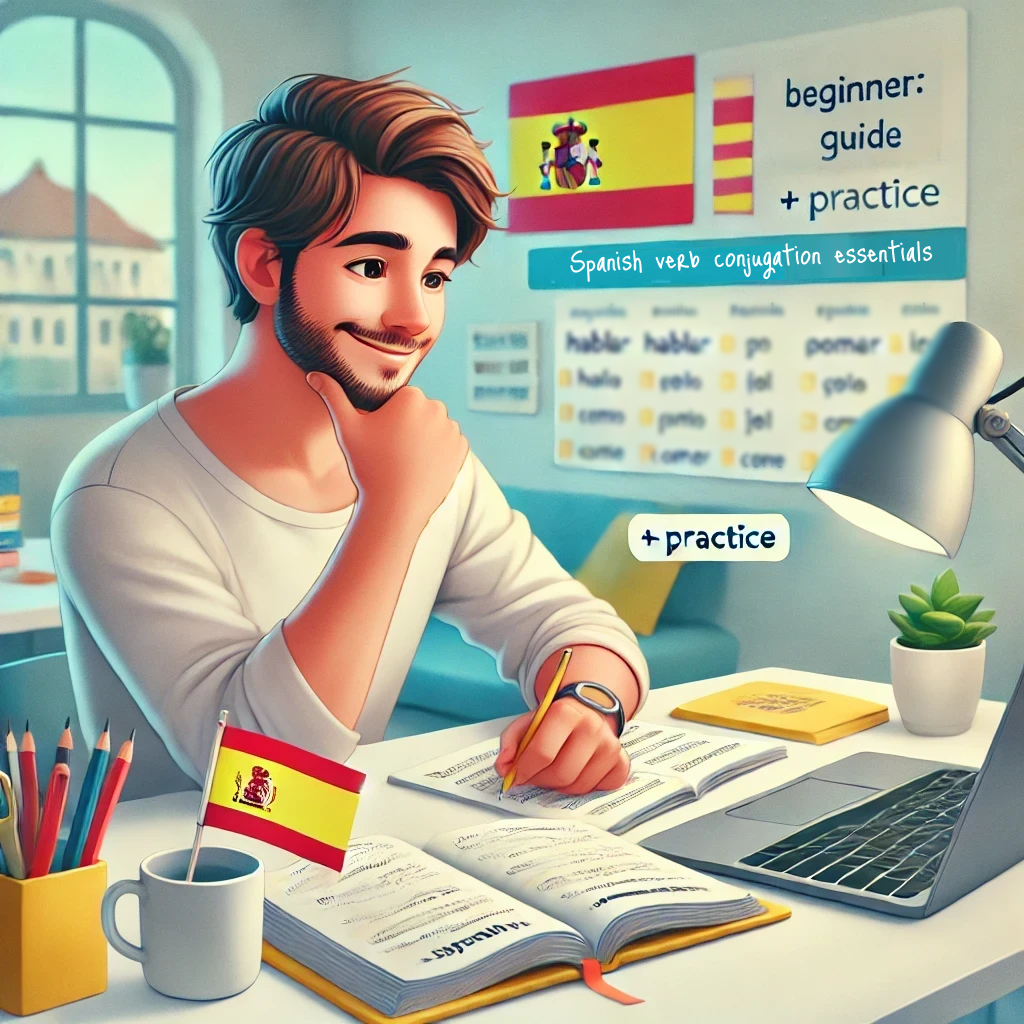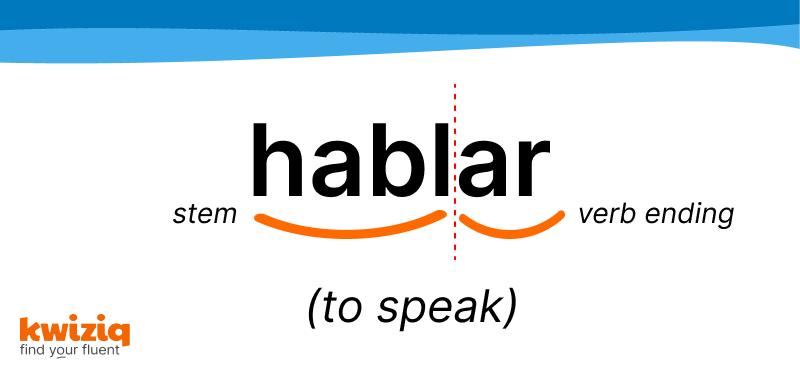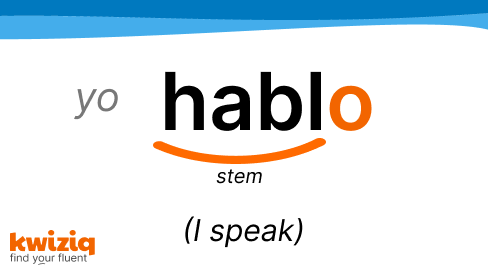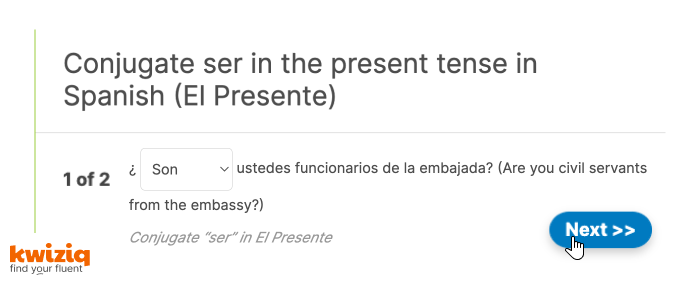
Table of Contents
- Infinitives and Verb Conjugation Groups
- Ser and Estar - Irregular and Indispensable Spanish Verbs
- 2 Ways to Practise Spanish Verb Conjugations
The verb is an important element in a sentence, if not the most important, as it expresses the existence, the state or the action. It takes different forms depending on who the subject is and also depending on the tense, mood and aspect.
One of the first goals learners have while learning Spanish is to communicate a thought, feeling or idea effectively, and to do this correctly, you'll need to be able to accurately conjugate verbs.
To conjugate a verb means to use a specific form of a verb that relates to a specific subject; this implies a modification of the basic form of the verb, also called the infinitive, by adding an ending to the stem of that verb. Here are a couple of examples using the present tense:
Yo compro flores.
I buy flowers.
Ella compra flores.
She buys flowers.
See how for different subjects (yo vs ella) we use the verb comprar (to buy) with a different ending that corresponds to those different subjects: -o for yo, -a for ella.
Conjugations in English are a lot simpler as they have fewer forms and changes, but look how in English you're also using a different form of the verb "to buy" for I and she in those examples: I buy, she buys.
By conjugating a Spanish verb correctly in a sentence, you'll be making sure you are conveying the meaning you actually want. You already do it every day in English and with practice you can master it in Spanish too!
Learning how to conjugate Spanish verbs is a big part of the learning process considering there are 18 different verb forms to learn. But trust us on this, once you've mastered the most common verbs and how to conjugate regular verbs, learning the rest of the Spanish conjugation rules will definitely come more easily. You will find lots of irregularities in different verbs and tenses which will need that extra practice, but that's what makes the Spanish language really interesting!
Here, we'll cover the basics of Spanish conjugation, important rules to remember, and regular and irregular verbs. If you've learned all these already, you might want to check out our guide to Advanced Spanish verb conjugation concepts.
Also, check out our guide to master more Spanish verb concepts (basic and advanced).
Infinitives and Verb Conjugation Groups
To conjugate a Spanish verb, you need to know the infinitive form of the verb.
What is an infinitive?
An infinitive is the original form of the verb before it is conjugated; it is the most basic form of the verb. If you want to find a verb in the dictionary you will find it by looking at its infinitive; for example: hablar, comer, vivir, comprar, salir…
Why is the infinitive important?
The infinitive form of a verb is important to know because this is the essential version of the verb, the basic form, and we use it to conjugate the verb in different tenses. Knowing the infinitive form of the verb (and specifically its ending), will indicate which conjugation pattern you need to follow.
How many conjugation groups are there in Spanish?
There are 3 conjugation groups in Spanish, organised according to their endings:
- 1st group: verbs ending in -ar ("primera conjugación" or first conjugation)
- 2nd group: verbs ending in -er ("segunda conjugación" or second conjugation)
- 3rd group: verbs ending in -ir ("tercera conjugación" or third conjugation)
To illustrate a simple example of the process of conjugation, have a look at how the form changes from the infinitive hablar (to speak) to when we say for example "I speak". The first thing to do is to drop the infinitive marker, in this case -ar, so we are left with the stem habl-.

Then the corresponding ending for the "yo" form in the present is added to it: hablo (I speak).

To see the present tense conjugations of regular verbs in more detail, you can see how these conjugations differ depending on whether they are an -ar, -er or -ir verb:
- Conjugate regular Spanish -ar verbs in the present tense
- Conjugate regular Spanish -er verbs in the present tense
- Conjugate regular Spanish -ir verbs in the present tense
Ser and Estar - Irregular and Indispensable Spanish Verbs
In Spanish, there are two verbs you will absolutely need to master: ser and estar. Both of them are equally important and used in different contexts, though they mean the same thing: "to be".
It's important to master the different uses and conjugations of these two verbs not only because they are essential, everyday verbs, but also because they are used as part of verbal structures like the passive or progressive tenses.
Ser and estar conjugations in many tenses don't follow the general rules for regular verbs since they are irregular. It's important to learn their conjugations from the beginning, starting with the present tense:
There are many use cases and rules to learn when talking about these two Spanish verbs, so you can go into much more detail on the difference between ser and estar, when to use each one and how to practise this specific topic.
2 Ways to Practise Spanish Verb Conjugations
Now that you've started getting immersed in Spanish verbs, rules and conjugations, it's time to start practising!
Whether you are a beginning, intermediate, or advanced Spanish learner, there is always room for improvement when it comes to verb conjugation. So here are 2 effective ways to practise your Spanish verb conjugations:
1. Study our conjugation-focused lessons
We have hundreds of Spanish lessons for you to progress faster in your learning journey.
Among these, there are many dedicated specifically to Spanish verb conjugation rules.
You'll get a concise explanation on how to conjugate verbs in every tense, partnered with useful examples and audio files to practise your listening and speaking skills while you're at it. Not to mention (and this is a user favourite) our microkwizzes, which are quick and simple 2-question kwizzes to test your understanding of that specific lesson.
2. Test your progress with Spanish fill-in-the-blanks exercises
If you want to test your knowledge, try out our grammar fill-in-the-blanks exercises (and, psst, we also have vocabulary ones!). Some of them are specifically designed to help you gauge your understanding of verb conjugations in different tenses and moods in a way that's convenient and easy to understand.
Our Spanish fill-in-the-blanks tests allow you to apply your knowledge in a more authentic way, because instead of simply memorising conjugations, you are required to actually use your understanding of the language to complete the test. This helps to develop your skills in a more meaningful way, and it can be more rewarding to see your progress
Plus, the tests are automatically graded, so you get immediate feedback on your performance.
That's it for now! If you're still reading, congrats! That means you're really committed to your Spanish verb practice.
Access our numerous tools and resources to help you master your Spanish verb conjugation skills by creating your free Kwiziq Spanish account!
With your personalised study plan, interactive exercises, and uniquely efficient kwizzes, you'll get targeted practice and be able to track your progress over time. And, with access to our verb tables, you'll have everything you need to master your Spanish verb conjugation skills.
So why wait? Create your account today and take the first step towards fluency in Spanish!

